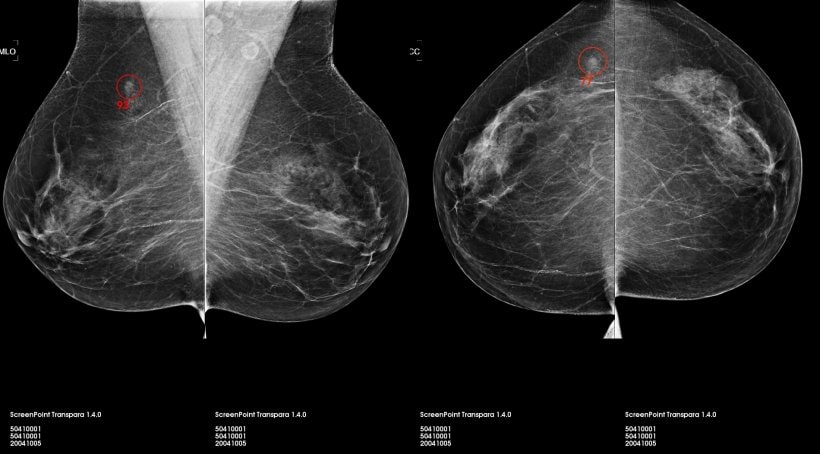Device Use Environments
When developing a device, conscious visual associations should be made with its use environments and products that can be found within them for visual cohesion and device visual appropriateness.
Visual relationships between the device, its use environment and their products within them should be considered.
Bayer devices and graphic user interfaces are not solely utilized in Radiology suites, future revisions of this guidance will provide additional use environments than the ones described below.
Use Environments
There are 3 main visual distinct use environments within the imaging setting:
- ‘Clinical’
- ‘Ambient’ and
- ‘Utility’ types.
Clinical Type Suites
Clinical type suites convey precision, cutting edge, professional & sterile/clinical qualities. Equipment is often ceiling mounted and is predominantly neutral in color.
A visually “brochure-esque” suite type. Not necessarily a common environment but can be seen as aspirational for reference when developing a Radiology device for Bayer.

Visual characteristics:
- Lighting: Neutral white/ cool bright lighting.
- Colors: Neutral, predominantly white, light greys, black.
- Materials: Smooth plastics, metallics.
- Typical Finishes/ Surfaces in suite: Mix of matte, satin & reflective, metallic, large stark surfaces found in room and objects in it.
- Décor: Formal, minimal, neutral, spacious (uses a lot of negative space), stark, clean.
Ambient Type Suites
Ambient type suites create an altered ambience by use of mood lighting to change the experience of undergoing a scan procedure. These suites are typically themed to incorporate elements of nature to promote a calm feeling or are pediatrically or ‘futuristically’ themed.

Visual characteristics:
- Lighting: Mood lighting, both warm & cool light are used depending on the theme. Cool lighting seems to be used for futuristic themes.
- Colors: Neutral or warm colored objects, however lighting heavily influences color.
- Materials: Smooth plastics, metallics, timbers.
- Typical Finishes/ Surfaces in suite: Mix of matte & reflective surfaces, large & broken up surfaces on objects and room.
- Décor: Themed, modern, in-built storage, uncluttered.
Utility Type Suites
Utility type suites focus on practicality, giving them a utilitarian appearance and generally make up for the majority of the suite types found to date. Whilst not seen as aspirational reference, devices developed should aim to form a visual relationship and appropriateness within it.

Visual characteristics:
- Lighting: Spot or fluorescent lighting, can be dim or bright.
- Colors: Generally warm, off-whites, beiges, pale, greys.
- Materials: Textured plastics, powder coated metals, some suites have a small amount of uncoated metals & timbers.
- Typical Finishes/Surfaces in suite: Mostly matte/ dull, minimal reflective surfaces, room may have more several different pronounced textures/patterns.
- Décor: Practical, can come across dated, can be cluttered with equipment/storage.
Scanners & Parallel Products
It is likewise important to consciously create visual relationships with parallel products within the device’s use environment.
In particular, visual relationships and cohesion should be made with image scanners as it is typically the product with the most presence in an imaging suite and its use is heavily interlinked with Radiology devices.
- 1/2
- 2/2

(Sources: https ://www.medicaldevice-network.com/projects/siemens-somatom-x-cite-ct-scanner/
https://www.siemens-healthineers.com/en-au/computed-tomography
https://avantehs.com/p/siemens-somatom-definition-flash-ct-scanner/13811)

(Sources: https ://www.red-dot.org/ko/project/incisive-ct-39368
https://ifworlddesignguide.com/entry/131075-iqon-spectral-ct
https://www.philips.com.au/healthcare/product/HCNCTD001/mx16evo-ct-scanner)
Trends
The sole intent of this section is to outline some current and emerging trends and technologies within and outside the medical environment to facilitate discussion and as stimulus during the development of Radiology devices.
As each device has its own unique needs, goals and requirements, it is up to the development team to determine if these trends are applicable to the device during development.
Interactions & Experience
Image Recognition
Image and facial recognition have a multitude of applications in the healthcare environment including patient monitoring, and digital health record data access.
Currently seen in consumer products, image & facial recognition is used for logging in, replacing passwords & fingerprint scans. It can decrease mental tasks and eliminate login screens and provide secure access to devices for different user profiles & different privilege settings.

Voice Recognition & Sound Design
Voice command driven applications and control devices may be increasingly applicable for use in healthcare, particularly in work environments which require heavy multitasking whilst operating devices. Auditory input aids users and operators in task completion, free-up hands and allowing users to perform other physical tasks.
Audio or sound design as an interaction is also becoming significantly relevant in enhancing device functionality and in providing intrinsic feedback beyond visual indicators.
As voice recognition becomes more reliable and AI technology becomes more advanced, virtual assistants such as Google’s ‘Alexa’ and Apple’s ‘Siri’ have become normalized, readily adopted by the average users and changing the ways our customers interact with devices.
By extension, potential benefits can be seen for this technology in healthcare by way of assisting in automation, making tasks less time consuming and to increase convenience, task accuracy or simply interacting with search engines and accessing information.
Bayer Pharma has developed a Google application for healthcare professionals, with trigger commands such as “Hey Google, talk to Bayer Pharmaceuticals“.

Future Working Environments: Smart Spaces
A smart space is a physical or digital environment in which people and technology-enabled systems interact, which helps automate functions. IoT can also be used to create ‘smart spaces’ for benefits such as reducing power consumption and creating ideal environmental conditions (e.g. temperature, lighting). With the rise of mobile computing, smart sensors and IoT, smart spaces and interconnected technologies are increasingly becoming available & affordable for users to remotely access, adjust and monitor devices in and around the home.

Alexa can now be instructed to activate secondary devices such as Roomba®, Sonos® and other home devices. This trend is likely to reach the healthcare industry to enhance user workflow.

AI/ Machine Learning
AI and Machine Learning are tapped as another major trend in medical innovation used for training, monitoring, processing results and for decision support. AI allows for the faster processing of large data sets and integration of multiple data streams that otherwise wouldn’t be possible. In mammography, AI is already being used to process images 30x faster, with a 99% accuracy to help in the diagnosis of cancer1.
Whether through voice recognition, visual interfaces, or other methods of interfacing, akin to automation AI may help in supporting device users by preprocessing information and proposing options for treatment or procedure settings.
For an example Bayer machine-learning product see the Workflow Solutions // Insights product:

(Source: https ://healthcare-in-europe.com/en/news/the-value-of-ai-in-breast-screening.html)
Source 1 – FIONA MACDONALD, 19 SEP 2016, www.sciencealert.com, last accessed 8 OCT 2020. AI Can Analyze Mammogram Results 30 Times Faster Than Doctors, And With 99% Accuracy.
Design Movements
Device Agnosticism
The rapid expansion of smart phones, tablets, laptops and other personal computing devices alongside increasing internet access has forced service providers and designers to develop seamless experiences across devices.
An ongoing process of data synchronization across two or more devices lets a user continue their product use consistently without losing their place, needing to learn a new UI or setup preferences for each device. This trend can also be applied to the diagnostic imaging environment, where devices and interfaces in the scan room, control room and patient registration area can be synchronized.

Device Agnosticism (or Continuous Design), creating consistent and recognizable design cues, elements and experiences across a brand’s products can help reinforce familiarity, seamlessness and therefore greater efficiency, satisfaction and experience across multiple devices.
Preferences, styles and UI elements can be consistently applied irrespective of the device in use, whether using a smartwatch, phone, tablet, TV or specialized device as an interface.

Human/ Patient Centered Design
Human centered design practices have been put in the forefront of general design and in certain medical product categories where patients took a back seat to the device users such as healthcare professionals and operators.
Design methodologies which focus on human centered practice include “Co-creation”, a technique that involves users and stakeholders in the design/development process. Co-creation workshops are sessions with these stakeholders to understand and confirm existing workflows and to explore new solutions. Often developer and users create hands-on mock-ups together in context.
Benefits and effects of focusing on the patient, although simple in practice is powerful as consumer and patient awareness are starting to form prerequisites as influential stakeholders and decision makers.

Simple Complexity
A strong drive to a ‘less is more’ approach in terms of aesthetics have been generally adopted. Products have increasingly adopted simplified, minimal aesthetics as a tool to convey premium quality as opposed to use of over embellishment and treatment.
Use of simple geometric shapes and limited color pallets, finishes and stripping back of unnecessary details provide an unintimidating visual and ‘black box’ type connotation, hiding complexity within which lends in making products visually accessible.

(Sources: (left) https://www.bhphotovideo.com/c/product/965373-REG/steiner_6502_8x24_tactical_binocular.html (right) https://www.behance.net/gallery/65541221/VISIO.)
Medical Consumer
A shift in values as a consumer has altered the expectations for medical devices. Medical devices are becoming more consumer looking in appearance to address negative feelings of intimidation associated with them. Applying the principles of both ‘Simple Complexity’ and ‘Patient Centered Design’ trends has driven a movement to soften the qualities of ‘medical’, ‘clinical’, ‘sterile’ visual styles to create more familiar, simplified and unintimidating visual design for medical devices.

(Sources: (left) https://www.amazon.com/ANKOVO-Infrared-Forehead-Thermometer-Indicator/dp/B01M74F3NH/ref=as_li_tl?ie=UTF8&camp=1789&creative=9325&creativeASIN=B01M74F3NH&linkCode=as2&tag=mostbest7-20&linkId=0n0e1sjgdt17lgev8i5gvg1829pyc20v (right) https://www.mobihealthnews.com/content/nokia-withings-launch-thermo-wifi-enabled-fda-cleared-thermometer)
Sustainability
Sustainability practices are becoming more emphasized, beginning to be seen as a necessity, as an overall awareness of the environment, limited availability of resources and drivers such as budget pressure increase.
Areas where practicing sustainability sees particular benefits are in high volume, disposable products and packaging where even incremental improvements, such as minimizing material usage and changing material types, become significant in reducing waste, impact on the environment and saved cost.
The medical industry has in the past typically valued safety and quality of treatment over sustainability, however as financial and environmental pressures increase, designers, engineers and companies are increasingly approaching sustainability as a necessity and no longer just as only a marketing strategy. Especially due to Bayer’s global market share in the area of CT, the use and discard of millions of syringe kits add substantially to the landfill.
Forms of sustainability strategies include circular manufacturing, refurbishment of in-field devices, which involves stewardship of a used device. Refurbishment (with new or used components) suitable for secondary on sale. Other strategies include Product Line Engineering where different product lines share similar platforms and componentry, not only streamlining production (reduce need for numerous bespoke assembly lines) and inventory but can contribute to minimize product or componentry obsolescence allowing easier repair, upgrades and refurbishment.

If you have any further questions about this or any other section of Bayer Identity Net, please contact:





